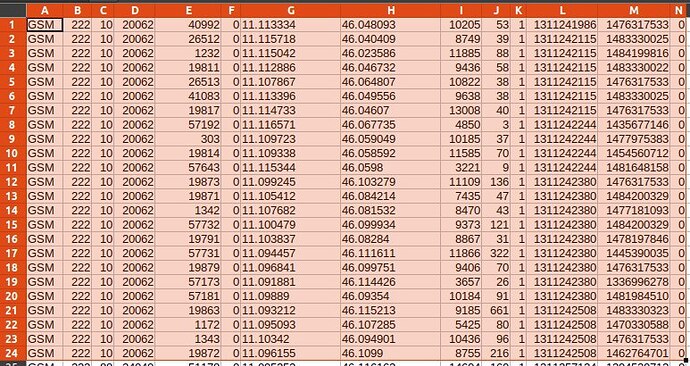Hi all guys, I’m new here.
Is possible to extract only the position of the 4G basestations in my area from the OpenCellId database? I tried to extract the word “4G” but in my opinion there are too many. Could it be that it also includes other points?
Search for Country (MCC) and/or NET and/or LAT/LON.
Maybe I’d better rephrase the sentence. Is it possible that for a specific basestation in the database there are multiple rows with different positions?
Do I have to make an estimate to get a position?
Of course they are many lines for each base station. All lines are data collected and you must make a research for a particular base. Lines can belong to different Sectors in a BS.
Also, you must extract the BS id from Cell id, BS = int(Cellid/256). Sector id = remainder * 256.
Except the use of public data, i use a Python script to plot all relevant lines in a Google Earth file (kml), so i can visualize the spread of the measurements and pinpoint the approximate center (BS).
Is your python script opensource? Is it possible to collaborate?
Sure!
Every month I extract from my country three (3) nets to GSM and LTE csvs, and then i use them to get all data I need to txt, csv, and kml files.
If you know Python, I can give you any script I wrote. If not, I can extract any data you need.
Yes I love python. I’m working on my university thesis project. If you can share the code I’ll try to take a look!
@dalex thanks for your explanation. I would also like to see your Python code, if possible please.
Additionally, it would be great if you could add more description to explain why you divide the cell id by 256 to get the BS id?
And in terms of definitions, I broadly get the right number of sites for my chosen country if I:
- divide the cell id as you suggest by 256
- then divide the number of unique cell ids by 3 (assuming 3 cells per site).
Would you say this is broadly correct in your opinion?
256 cells per Base Station is the original design of the 4G scheme. This is to allow many cells in each of the available bands.
Division by 3 is wrong. A common scheme the networks adopt, is something like this (example):
1 - 9 : 1800 band
11 - 19 : again 1800 (2nd channel in CA?)
21 - 29 : 2600 band
31 - 39 : again 2600 (TD ?)
41 - 49 : 2100 band (taken from 3G for 5G NSA)
61 - 69 : 700 band (5G NSA)
81 - 89 : 800 band
and so on. That sceme allows up to 9 sectors for each band.
Hi Dalex, Can you cite your reference for this information, please? Any book or paper.
Thank you.
